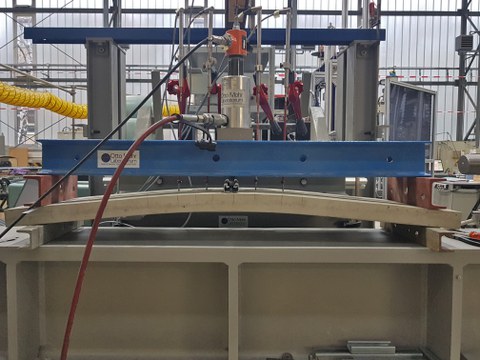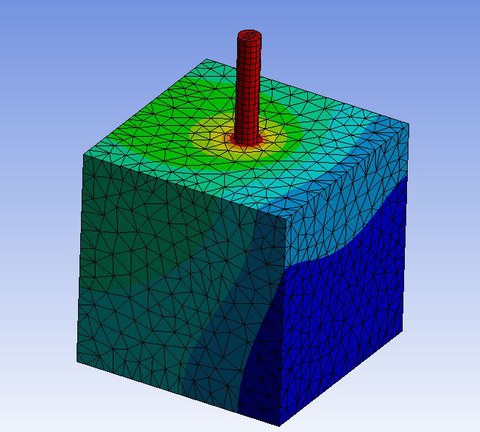TP4: Connections according to structural requirements (TAVIMBA)
Table of contents
Project data
| Titel | Title TP 4: Auslegung der Verbindungen gemäß bautechnischer Anforderungen im Verbundprojekt: Thermisch aktivierte Verbindungen im Modularen Bauen (TAVIMBA) | TP4: Design of the connections according to structural requirements as part of the joint research project: Thermally activated connections in modular construction (TAVIMBA) Förderer | Funding Bundesministerium für Bildung und Forschung (BMBF); Projektträger: FZ Jülich GmbH / smart3 Zeitraum | Period 09.2018 – 08.2021 Leiter Teilprojekt | Subproject manager Prof. Dr.-Ing. Dr.-Ing. E.h. Manfred Curbach Bearbeiter | Contributor Dipl.-Ing. Dominik Schlüter Projektpartner | Project Partners 4 Partner, davon 2 aus der Forschung und 2 Firmen |
Report in the annual report 2020
BLIND CONNECTION

Determination of the pull-out force of a novel joint technology
The material carbon concrete enables the production of thin-walled slabs. Furthermore, carbon concrete is suitable for modular construction processes. New fastening systems are needed to connect the thin, prefabricated components on the construction site. Three main development goals are in the foreground. First, the safe transmission of forces from the fastener to the thin-walled slab; second, simple assembly; and third, the fastening system should have as little impact as possible on the aesthetics.
As part of the “TAVIMBA” project, new fastening systems are being developed that function based on shape memory alloys (FGL). The FGL is used as an active fastening element. Thermal or electrical activation causes it to expand and thereby clamp into a mounting rail, creating a force-fit connection. With this form of activation, mechanical accessibility within the joint area is not needed. The connection can thus be made blindly, and the mounting point is not visible from the outside.
Within the project, different concepts for the implementation of such a fastening system were developed and investigated. Two points were of particular interest: On the one hand, the connection point between FGL and mounting rail and, on the other hand, the connection point between mounting rail and thin-walled slab made of carbon concrete.
For the joint between FGL and rail, numerical and experimental investigations were carried out by the project partners to understand and improve both the joining process and the influencing parameters. In this way, it was possible to generate a sufficient pull-out force of the FGL from the mounting rail. Different approaches were implemented and experimentally tested for the connection of the mounting rail to the thin-walled slab. It was shown that complete embedding of the rail in the slab is possible.
For the application of a “curtain-type, rear-ventilated facade”, the component-type tests are yet to be carried out. Further, a demonstrator will be implemented. Future research goals are to transfer this concept to detachable connections. In turn, this will enable the implementation of a sustainable modular, detachable construction method. Extensive research and development steps are required in this area.
Report in the annual report 2019
CROSS-INDUSTRY INNOVATION - CARBONBETON CONNECTS

Rendering of a shape memory alloy torsion anchor
Currently, there is a great demand in Germany for educational, commercial and residential buildings. Flexible construction methods such as “modular construction” have the potential to meet this demand. Within this construction method, parts of the building - such as the facade - consist of prefabricated modules that will be assembled on-site. The individual modules are conventionally connected to each other by means of inserts or grouted joints. This requires mechanical accessibility of the joints for assembly and disassembly. If the connection is made by means of grouting, it is no longer possible to loosen them at all, making it difficult to reuse the components.
In the project “Thermally activated joints in modular construction (TAVIMBA)” smart joints are to be developed which can be closed and, if necessary, reopened without mechanical accessibility. For this purpose, solutions based on thermal shape memory alloys (SMA) are to be developed which can be opened and, if necessary, closed again by means of thermal or electrical stimulation. Their almost 100 % structural integration should enable connections that are less space-intensive and thus enable a connection of thin components made of carbon concrete.

Thermal analysis of the shape memory alloy at activation
Thermal shape memory alloys have the ability to react to changes in the thermal field with reversible mechanical changes. In the martensitic state, an element made of SMA can apparently be deformed plastically (pseudoplastic). If the element is subsequently heated above its transformation temperature, it resumes its previously imprinted shape. With the help of this effect, connecting elements are to be developed which connect modular components (facades, concrete slabs, beams, columns, ...) in a safe, fast and reliable way.
The Institute of Concrete Structures supports the development of the overall design of the connection. The connection must be designed in such a way that all the safety-relevant static requirements and a safe load transfer into thin components are guaranteed. In order to achieve this goal, both theoretical considerations and practical testing and determination of component resistances have to be carried out.
